As we approach 2025, the desire for comfort and meaningful connection at home continues to grow. People are moving away from stark minimalism, embracing spaces that feel vibrant, cozy, and alive.
The interior design warm trend is reshaping how we think about our living environments, transforming ordinary rooms into havens of well-being and style. Imagine your home filled with inviting colors, tactile materials, and a sense of warmth that welcomes you every day.
This guide is your roadmap to the top warm design trends for 2025. Discover how to bring color, texture, and ambiance into every corner of your home for a look that is both welcoming and on-trend. Explore color palettes, materials, room-by-room ideas, styling tips, and future predictions to inspire your next design move.
The Rise of Warmth: Why Warm Interior Design is Dominating 2025
As we approach 2025, the world of interior design warm trends is experiencing a remarkable transformation. Homeowners and designers are moving away from the stark, cool minimalism of years past. Instead, there is a growing focus on warmth, comfort, and spaces that nurture emotional well-being.
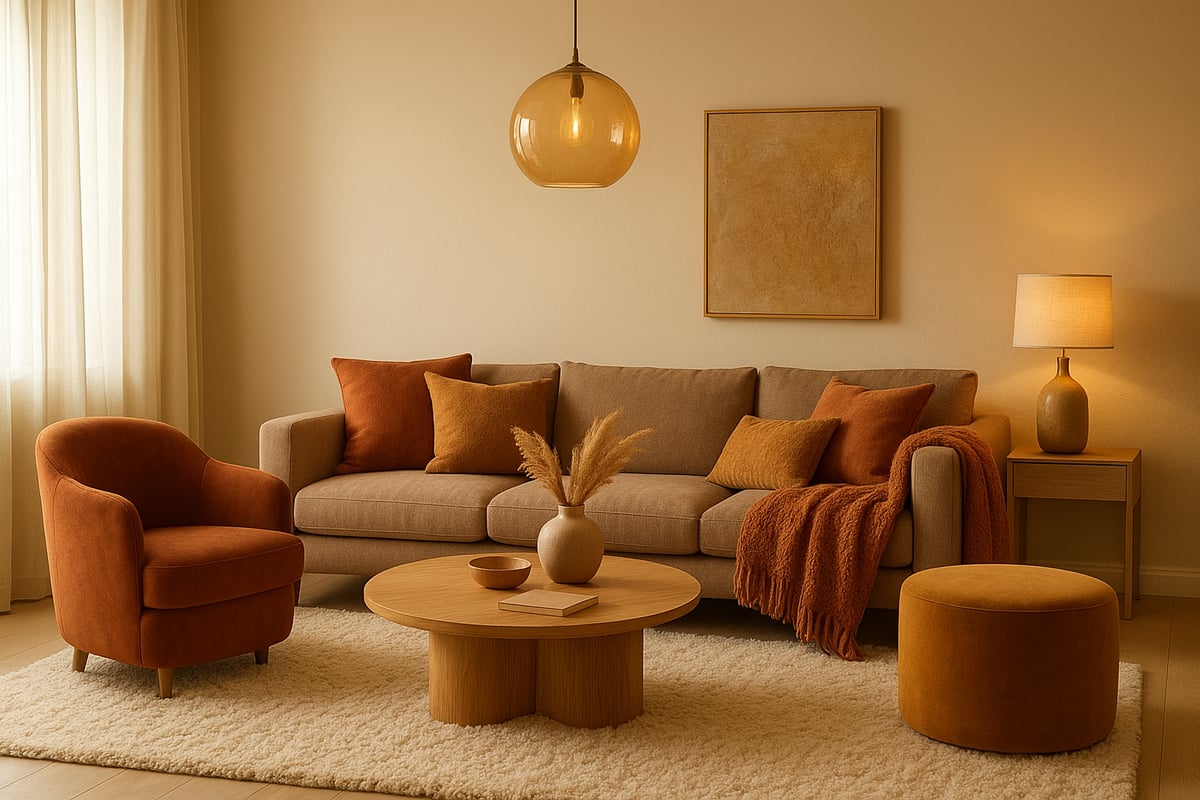
The Shift from Cool to Warm: A Brief History
The journey from cool, minimalist interiors to the current embrace of warmth is rooted in social and cultural shifts. In the early 2010s, sleek lines and neutral palettes defined modern homes. However, recent global events have encouraged people to seek comfort and connection within their living spaces. Wellness movements and biophilic design have further propelled this change, prioritizing natural elements and inviting atmospheres.
By 2024, interior design warm palettes gained momentum, with leading designers showcasing cozy, vibrant rooms. This trend mirrors the desire for emotional comfort and a sense of belonging. The emergence of “quiet luxury” and “soft minimalism” has also influenced the move, blending understated elegance with tactile comfort.
Today, interiors no longer shy away from boldness. Warmth is celebrated through layered colors and rich textures, creating spaces that feel both luxurious and lived-in.
The Psychology of Warmth in Design
Color psychology research reveals that warm hues—reds, oranges, yellows, and earthy tones—have a profound impact on mood and perception. These colors evoke feelings of security, optimism, and vitality, making them essential in interior design warm trends. When used thoughtfully, they can transform a room into a sanctuary of joy and connection.
Recent studies and 2025 design reports highlight a surge in the use of earthy browns, terracotta, and golden hues in major collections. Designers intentionally layer these shades to cultivate coziness and a welcoming ambiance.
People gravitate towards warm interiors because they satisfy a basic human desire for comfort. The right combination of colors and textures fosters a sense of belonging and emotional well-being, reinforcing the importance of warmth in modern design.
Data & Market Trends
Market data underscores the popularity of interior design warm palettes in 2025. According to industry surveys, over 60 percent of homeowners now prefer warm finishes in their main living spaces. Paint and furniture brands report significant increases in sales of golden ochre, soft brown, and terracotta shades.
Design events and awards have also recognized the rise of warmth. For example, the 2024 International Design Fair highlighted collections centered on tactile materials and inviting color schemes. For a deeper dive into these influential trends, the 2025 Interior Design Trends Guide offers expert insights and inspiration.
The data makes it clear that interior design warm elements are not just a passing fad. Instead, they represent a lasting shift in how we envision and experience our homes.
2025 Warm Color Palettes: Hues Defining the Year
As the world of interior design warm trends evolves, 2025 welcomes a celebration of vibrant, comforting colors. Homeowners and designers are shifting toward palettes that evoke optimism, coziness, and a sense of belonging. This year’s signature hues invite creativity, layering, and a personal touch, making every space feel both current and timeless.
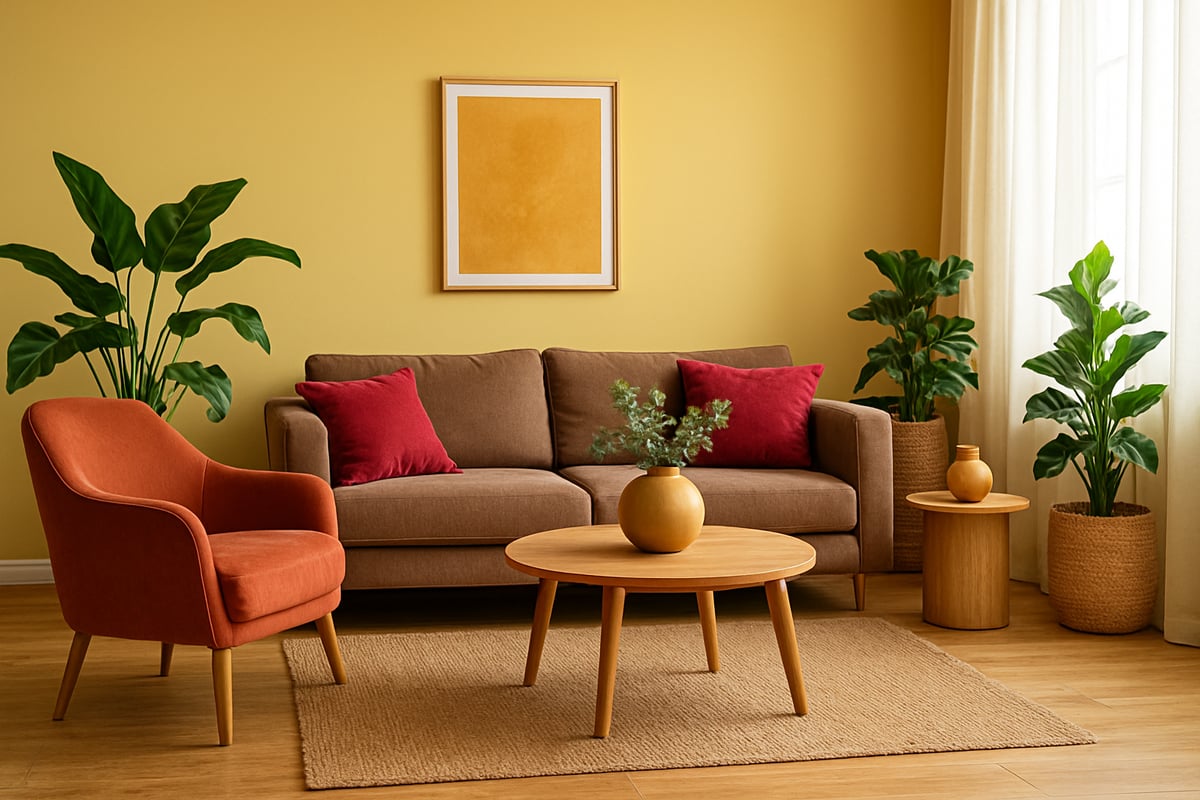
Trending Warm Colors for 2025
The interior design warm movement is defined by a palette that balances nostalgia with modern vibrancy. Leading paint brands and trend forecasters highlight several standout hues for the year:
| Color Name | Description | Mood/Energy | Pairings |
|---|---|---|---|
| Butter Yellow | Soft, creamy yellow | Uplifting, gentle | Blues, greens |
| Terracotta | Earthy, sun-baked orange-brown | Grounding, cozy | Neutrals, creams |
| Raspberry Red | Rich, deep pink-red | Playful, lively | Gold, warm browns |
| Soft Brown | Muted, caramel-like brown | Relaxed, stable | Whites, sage green |
| Retro Orange | Bold, vintage-inspired orange | Energetic, fun | Navy, beige |
| Golden Ochre | Warm, honeyed yellow | Inviting, sunny | Olive, taupe |
The interior design warm color palette for 2025 leans heavily on both muted and saturated tones. Muted shades like soft brown and butter yellow offer a serene backdrop, while saturated picks such as raspberry red and retro orange inject vibrancy. According to 2025 Interior Design Color Trends, these hues are gaining momentum in both residential and commercial spaces, reflecting a collective desire for warmth and positivity.
Layering these hues adds depth and coziness. For instance, pairing terracotta walls with golden ochre accents creates a sunlit ambiance, while butter yellow combined with leafy greens feels fresh and restorative. The interior design warm trends of 2025 encourage embracing color in thoughtful, balanced ways.
Room-by-Room Warm Palette Applications
Applying the interior design warm palette room by room allows for tailored comfort and visual interest throughout the home.
- Living Room: Opt for soft browns as the main color, accented by retro orange throws or pillows. Add warm blue accessories for a dynamic, yet soothing, gathering space.
- Bedroom: Layer pale pinks and golden yellows with earthy neutrals in bedding and curtains. Raspberry red can be introduced through artwork or a statement chair for a touch of playfulness.
- Kitchen & Dining: Terracotta backsplashes, golden ochre walls, and natural wood cabinetry create a convivial, welcoming space. Warm-toned dinnerware and brass accents enhance the palette.
- Bathroom: Use warm taupes for walls, complemented by muted coral towels and creamy white fixtures. These shades inspire a spa-like, comforting atmosphere.
- Entryway/Hall: Make a bold impression with raspberry red or golden hues on walls. Pair with natural fiber rugs and wooden benches for added warmth.
The interior design warm approach ensures each room feels intentional and harmonious. By mixing and matching these colors, homeowners can create spaces that reflect both personality and trend-conscious design.
Color Pairing Strategies
Effective use of the interior design warm palette involves both creativity and restraint. Combining warm hues with cool tones, neutrals, or textures can prevent overwhelm and create sophisticated results.
- Balance: Pair warm colors like terracotta or butter yellow with cooler undertones such as sage green or dusty blue for a grounded look.
- Accent Walls: Use a bold warm hue on one wall to anchor the space, while keeping the remaining walls neutral for contrast.
- Color-Blocking: Incorporate multiple warm shades in geometric patterns or stripes for a modern twist.
- Accessories: Introduce warm colors through artwork, ceramics, or textiles, allowing for easy updates as trends evolve.
Real-world designer projects in 2024 and 2025 often showcase layered approaches. For example, a bedroom might feature a golden ochre headboard, soft brown linens, and a pale pink accent wall, balanced by cool-toned lighting or metallic decor. The interior design warm philosophy emphasizes personalization, ensuring each color pairing feels curated and inviting.
Materials & Textures: The Foundation of Warmth
Creating a truly inviting home in 2025 starts with materials and textures. These elements form the backbone of any successful interior design warm approach, shaping not only the visual appeal but also the tactile comfort of a space.
From natural woods to plush textiles, the strategic use of materiality infuses warmth, personality, and lasting value into every room.
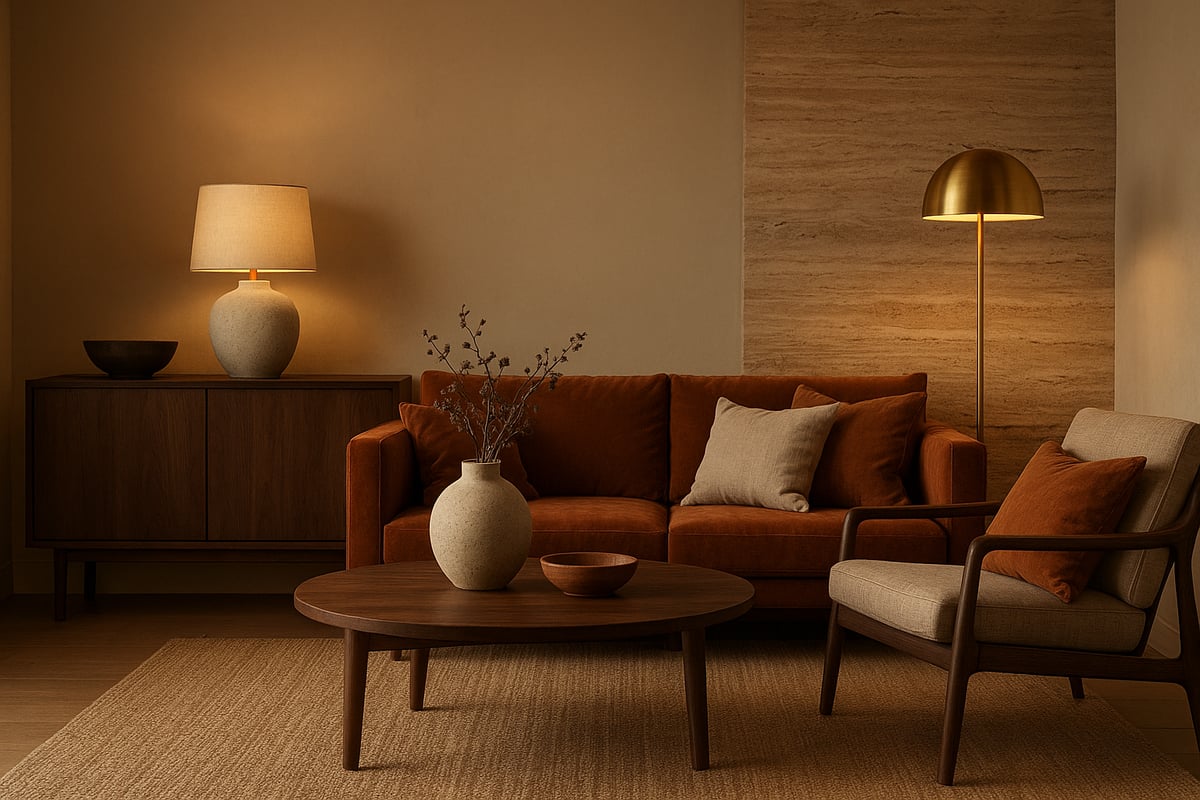
Natural Materials Leading the Trend
Natural materials define the interior design warm movement for 2025. Wood takes center stage, especially in darker stains like walnut and caramel, offering both richness and grounding. Stone surfaces—travertine, terracotta, and warm marble—bring organic character and a sense of permanence.
Textiles are equally vital. Linen, wool, bouclé, and velvet in warm hues add softness and depth to interiors. Metal accents in brass, bronze, and copper introduce a subtle glow, enhancing the overall warmth.
Designers are increasingly turning to these tactile, authentic materials to create layered, inviting environments. According to Materials and Textures in 2025 Interiors, earthy finishes and artisanal craftsmanship are central to this year’s most sought-after looks.
| Material | Warmth Factor | Best Room Applications |
|---|---|---|
| Walnut Wood | Rich, grounding | Living room, bedroom |
| Terracotta | Earthy, rustic | Kitchen, bathroom |
| Velvet | Soft, plush | Living room, bedroom |
| Brass | Subtle glow | Entryway, dining |
The right mix of these elements is essential for achieving an interior design warm enough to feel both stylish and comforting.
Layering Textures for a Cozy Effect
Texture is the secret ingredient in any interior design warm scheme. Combining hard materials like stone and wood with soft textiles creates depth and visual interest.
Think textured wall finishes—plaster, 3D tiles, or hand-crafted surfaces—paired with layered rugs, throws, and cushions. This interplay not only appeals to the eye but also invites touch.
For example, a living room might feature a travertine coffee table, linen drapes, and velvet pillows. The contrast between smooth and rough, matte and glossy, ensures the space feels dynamic and enveloping.
Layering textures is where interior design warm truly comes alive, turning ordinary rooms into cozy sanctuaries.
Sustainability and Warm Design
Sustainability is now at the heart of interior design warm trends. Homeowners increasingly seek eco-friendly options, from reclaimed woods to low-impact finishes. Artisanal, small-batch production is prized for both environmental and aesthetic reasons.
Brands are responding with collections that prioritize recycled materials and ethical sourcing. Consumers want their warm, inviting spaces to reflect their values as well as their taste.
Opting for natural fibers, FSC-certified woods, and non-toxic finishes ensures that interior design warm choices are as responsible as they are beautiful. This mindful approach adds another layer of comfort—peace of mind.
Lighting: Amplifying Warmth
Lighting is the finishing touch that can make or break an interior design warm environment. Ambient, diffused lighting sources—such as fabric-shaded lamps, warm LED bulbs, and brass sconces—amplify the richness of warm hues and textures.
Layered lighting solutions, like a mix of ceiling fixtures, wall lights, and table lamps, allow for flexibility and mood control. In every room, lighting should be designed to highlight natural materials and soften the overall effect.
Choosing the right fixtures and bulbs is essential for ensuring that your interior design warm palette glows at any hour. The right lighting brings out the best in every texture and material, creating a welcoming atmosphere for all.
Styling Warm Interiors: Practical Steps & Expert Tips
Creating a home that radiates warmth and comfort begins with an intentional approach. Each step in the interior design warm process plays a crucial role in shaping inviting, on-trend spaces. Here is a practical, expert-backed guide to transforming your home with warmth and style.
Step 1: Assessing Your Space and Goals
Begin your interior design warm journey by thoughtfully evaluating your home. Walk through each room, noting the existing colors, natural and artificial light, and architectural features. Pay attention to how each space currently feels—does it invite relaxation or feel too stark?
Define your desired mood for every room. Do you want a cozy retreat, a lively gathering spot, or a sophisticated sanctuary? List the areas that would benefit most from a warm update, such as living rooms, bedrooms, or entryways.
Consider making a quick sketch or using a digital tool to map out your space. This will help you visualize where warm elements can have the most impact. Setting clear goals ensures your interior design warm strategy aligns with your lifestyle and preferences.
Step 2: Selecting Core Warm Elements
Once you have assessed your space, select the foundational elements that will bring warmth to your interiors. Choose a primary warm color—such as terracotta, butter yellow, or raspberry red—as your anchor. This hue will set the tone for the room.
Next, decide on key materials. Wood, especially in caramel or walnut finishes, adds depth and comfort. For textiles, opt for natural fibers like linen, wool, or bouclé in warm shades. Stone accents, such as travertine or terracotta, can enhance the tactile appeal.
Create a moodboard using paint swatches, fabric samples, and photos. This step helps you see how different interior design warm elements interact before making any commitments. Take your time to ensure each choice complements your overall vision.
Step 3: Layering Colors and Textures
Layering is essential in interior design warm schemes. Start with your chosen wall color and build up through large furniture pieces, then add textiles and accents. Use a balance of muted and saturated tones to create depth without overwhelming the senses.
Mix textures for a multidimensional effect. Pair smooth stone floors with plush velvet cushions, or rough-hewn wood tables with soft linen drapes. This contrast enhances visual interest and tactile comfort.
For example, a terracotta wall combined with linen curtains and a velvet sofa epitomizes the layered richness of interior design warm trends. Remember, layering is about creating a sense of coziness and visual intrigue in every room.
Step 4: Balancing with Neutrals and Cool Tones
To prevent your interior design warm palette from feeling overpowering, integrate soft neutrals and occasional cool accents. Creamy whites, taupes, and pale greys offer breathing space between bold warm hues. This balance creates a sophisticated, harmonious environment.
Consider incorporating cool tones through accessories or artwork. A blue ceramic vase or green plant can provide refreshing contrast. Use accent walls or color-blocking techniques to highlight focal points while keeping the overall scheme grounded.
Keep in mind that restraint is key. Too many warm tones in one space can diminish their impact. Strive for harmony by thoughtfully mixing warm and cool elements in your interior design warm approach.
Step 5: Accessorizing and Personalizing
Accessories are the finishing touch in any interior design warm project. Select artwork, ceramics, and decor in complementary warm shades for added character. Plants and natural objects introduce organic warmth and vitality.
Layer in vintage or handcrafted pieces for depth and a sense of history. Textiles such as throws, cushions, and rugs in varied patterns and materials can personalize the space further. Lighting is also crucial—opt for brass fixtures, fabric shades, or warm LED bulbs to amplify the cozy atmosphere.
Arrange accessories in groupings to create visual interest. Each element should reflect your personality and enhance the overall warmth of your home’s design.
Expert Insights and Common Mistakes
Leading designers emphasize moderation and thoughtful layering in interior design warm spaces. One common mistake is relying too heavily on a single color, which can make a room feel flat. Instead, use a range of hues and textures for balance.
Another pitfall is neglecting lighting. Even the best color palette can fall short if the space is poorly lit. Choose warm, diffused lighting and layer sources for both function and ambiance.
For more expert strategies and practical advice, explore these Styling Warm Interiors: Expert Tips. Learning from professionals helps you avoid errors and achieve a polished, inviting look with your interior design warm scheme.
How to Use Design Tools & Resources for Warm Interiors
Digital resources make planning your interior design warm updates easier and more effective. Use moodboard tools and 3D visualization platforms to experiment with color palettes, materials, and layouts. Many online courses offer practical guidance on applying warm design concepts.
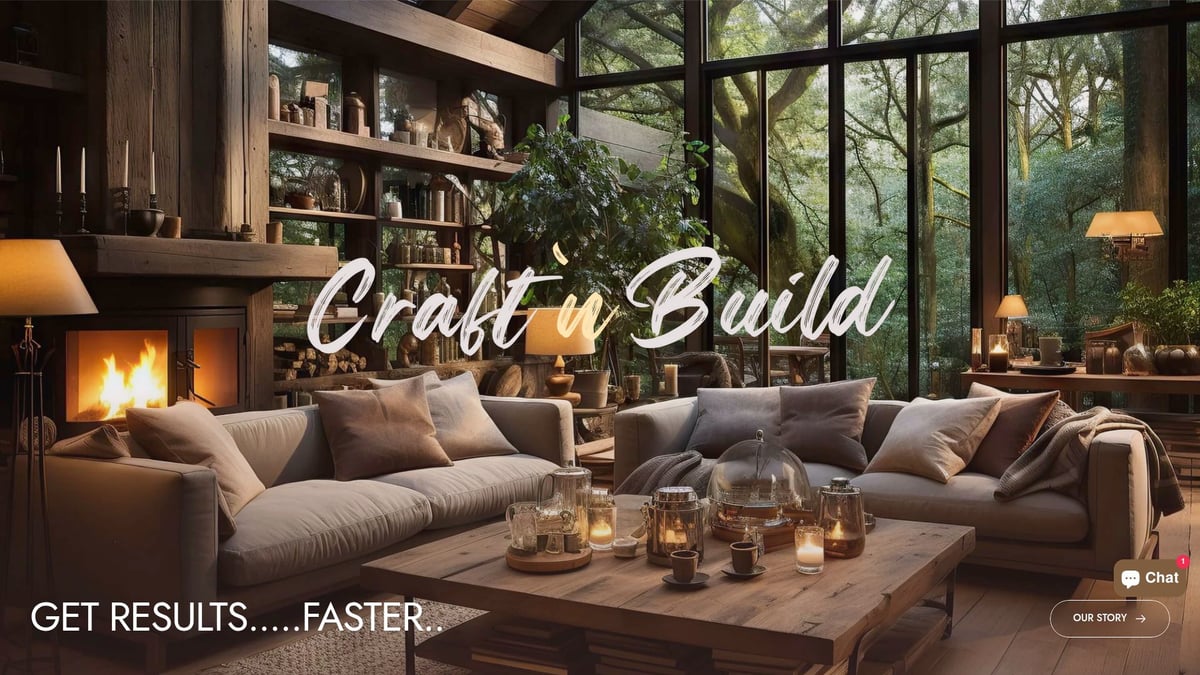
Websites like Craft’n Build Design Co. provide customizable templates and access to professional models. These resources empower both DIYers and designers to refine their vision before investing in materials or furnishings. Embracing technology ensures your interior design warm project is both inspired and well-executed.
Warmth by Room: Transforming Every Space
Creating a welcoming home in 2025 means tailoring interior design warm trends to each space. Every room offers unique opportunities to infuse warmth, comfort, and style. By thoughtfully applying color, material, and lighting choices, you can transform your home into a cohesive sanctuary.
Living Room: The Heart of Warmth
The living room is often the centerpiece for interior design warm trends. Use soft browns on plush seating, layer in retro orange cushions, and add textured textiles like bouclé throws for instant coziness.
- Layer area rugs in earthy tones for a grounded feel.
- Incorporate natural wood coffee tables and brass lighting for visual warmth.
- Use wall art in raspberry red or golden ochre to energize the space.
A 2024/2025 living room case study showcases retro orange accent chairs paired with walnut furniture and soft brown sofas. For more curated inspiration, explore Warm Interior Design Collections that highlight products tailored for inviting spaces.
Bedroom: Serene and Inviting Retreats
Bring tranquility to your bedroom with interior design warm palettes. Opt for pale pink walls, golden yellow throws, and creamy neutral linens to evoke restfulness.
- Choose soft linen or velvet bedding for tactile comfort.
- Add raspberry red accent pillows for depth.
- Select diffused bedside lighting in warm tones.
An example makeover features a creamy neutral base, raspberry red accessories, and golden yellow curtains, creating a serene yet vibrant retreat. Layering gentle hues and textures fosters a restorative environment.
Kitchen & Dining: Gathering in Warmth
The kitchen and dining area are ideal for showcasing interior design warm materials. Terracotta backsplashes, wooden cabinetry, and golden ochre walls create a convivial, stylish atmosphere.
- Use brass hardware for a subtle glow.
- Display open shelving with warm-toned dinnerware.
- Incorporate natural stone or wood dining tables.
Pairing terracotta with natural wood and golden ochre accents fosters a gathering space that feels both modern and timeless. Draw inspiration from curated collections that celebrate these warm, welcoming combinations.
Bathroom: Spa-like Comfort
Transform your bathroom into a spa-like retreat using interior design warm elements. Start with warm taupe walls, stone sinks, and wood vanities for an earthy foundation.
- Add muted coral towels and creamy white accessories.
- Use ambient lighting, such as fabric-shaded sconces, for a soothing effect.
- Incorporate small touches like warm-toned mats and natural decor for comfort.
Even compact bathrooms benefit from strategic color and material choices, ensuring relaxation and warmth in every detail.
Entryway & Hall: First Impressions
Set a welcoming tone at the entrance with interior design warm hues. Raspberry red or gold-toned walls make a bold statement, while natural fiber rugs and wooden benches add organic texture.
- Choose statement lighting in brass or bronze finishes.
- Use wall hooks or shelves in caramel wood tones.
- Display artwork or mirrors with golden frames.
A thoughtfully styled entryway not only impresses guests but also unifies the home's overall warmth. For more ideas and resources on warm design, visit Interior Design Blog Resources for expert tips and trend updates.
Each room, when approached with interior design warm strategies, becomes a unique expression of comfort and style. By layering color, texture, and thoughtful accessories, you create a cohesive, inviting home that reflects the best of 2025’s trends.
Future Forecast: What’s Next for Warm Interior Design?
As 2025 approaches, interior design warm trends are evolving in exciting directions. The future promises a blend of innovation, global inspiration, and a renewed focus on comfort and sustainability. Let’s explore what’s on the horizon for interior design warm spaces.
Emerging Micro-Trends
The next wave of interior design warm is defined by subtle shifts and creative blends. “New neutrals” such as muted peach, clay, and honeyed beige are rising, bringing gentle warmth without overwhelming a space. Soft minimalism is gaining ground, combining clean lines with cozy, tactile materials. Artisanal finishes, like hand-thrown ceramics and textured wall treatments, add unique character and a sense of craftsmanship to interiors.
Designers are layering these trends to create spaces that feel both curated and personal. The result is an interior design warm approach that balances simplicity with richness, making homes feel more inviting and lived-in.
Technology and Innovation
Technology is reshaping interior design warm environments. Smart lighting systems allow homeowners to adjust warmth and ambiance at the touch of a button. Climate control technologies are being seamlessly integrated, ensuring comfort year-round while supporting energy efficiency.
Materials are also advancing. 3D-printed decor elements are making custom, sustainable designs more accessible. Eco-friendly innovations, such as recycled woods and low-VOC finishes, are now staples in high-end and mainstream projects alike. These advancements make it easier to achieve an interior design warm atmosphere without sacrificing environmental responsibility.
Global Influences
Interior design warm trends for 2025 are increasingly global in scope. Mediterranean aesthetics contribute sun-baked terracottas and rustic textures, while Japanese interiors bring in natural woods and serene simplicity. Scandinavian design, with its emphasis on coziness and practical beauty, continues to inspire layered textiles and light wood finishes.
Cross-cultural palettes blend these influences, resulting in spaces that feel both universal and deeply personal. Whether you prefer the earthy tones of the Mediterranean or the soft minimalism of Nordic style, the future of interior design warm is about embracing the best of multiple worlds.
Data-Driven Predictions
Industry reports from 2024 and 2025 highlight a growing demand for interior design warm palettes and materials. Surveys show that over 60% of homeowners now prefer warm color schemes for main living areas. Sales of brass fixtures, terracotta tiles, and plush textiles have increased significantly.
| Trend | Popularity (%) | Notable Materials |
|---|---|---|
| Warm Palettes | 62 | Terracotta, ochre, clay |
| Layered Textures | 58 | Velvet, linen, wool |
| Sustainable Finishes | 55 | Recycled wood, low-VOC |
Personalization and flexibility are also on the rise, with more homeowners seeking unique, adaptable solutions for their interior design warm projects.
Key Takeaways for Homeowners and Designers
Investing in interior design warm is a future-proof choice. These trends offer both timeless appeal and adaptability, ensuring your space feels current yet enduring. To stay ahead, focus on blending new neutrals, integrating smart technology, and drawing inspiration from global sources.
For those eager to deepen their expertise, Online Learning for Interior Design provides courses and resources to help you master the latest warm design techniques. Continued learning ensures your interior design warm projects remain stylish, functional, and ahead of the curve.
As you’ve seen throughout this guide, creating a warm and inviting interior is all about thoughtful choices—color, texture, and the right materials. If you’re inspired to bring these 2025 trends into your own home but aren’t sure where to begin, taking the next step in your design journey can make all the difference. Whether you’re new to the field or looking to refine your skills, you’ll find practical techniques and expert insights that empower you to transform any space. Ready to turn inspiration into reality? Get started with Interior Design and start shaping your ideal home today.




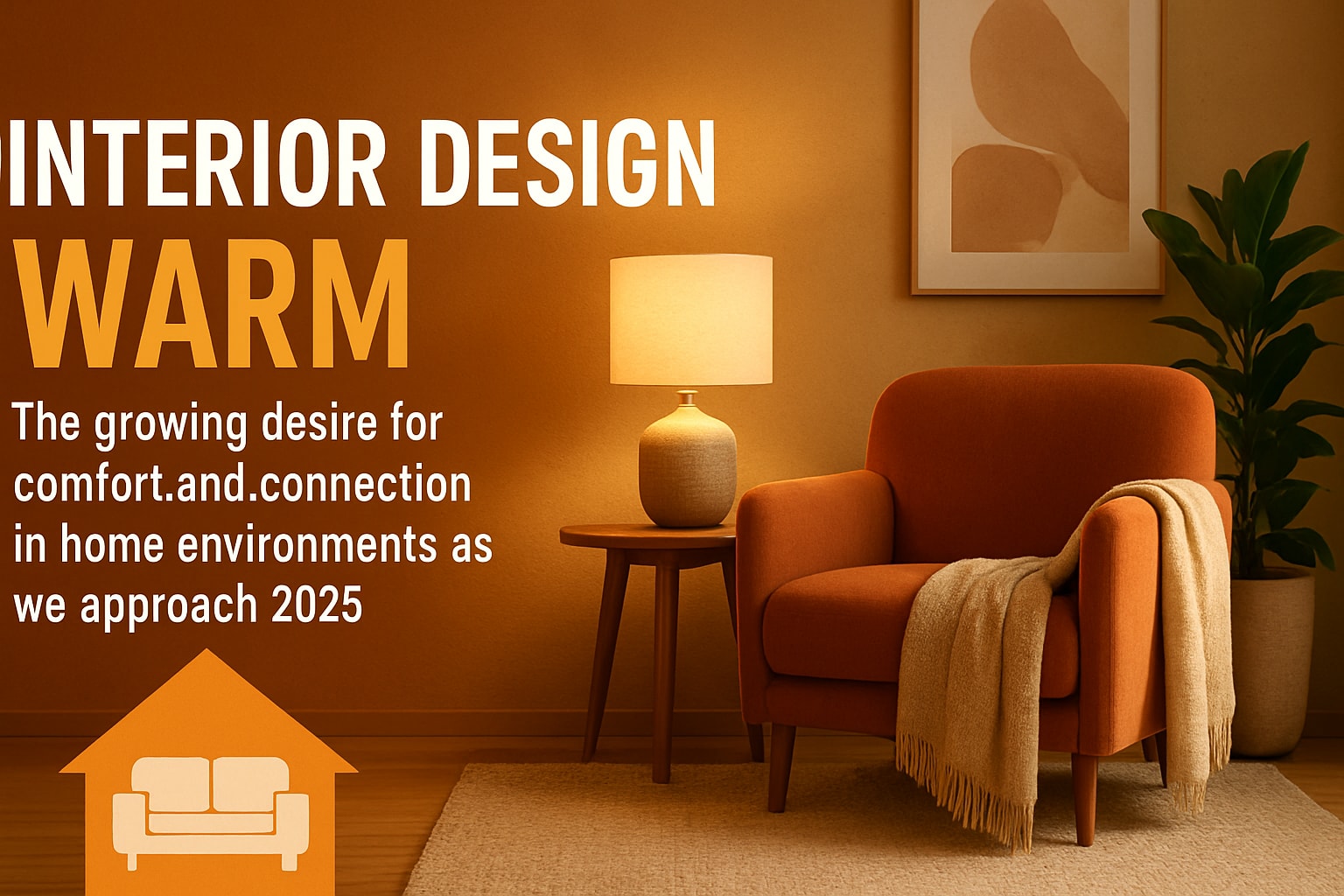


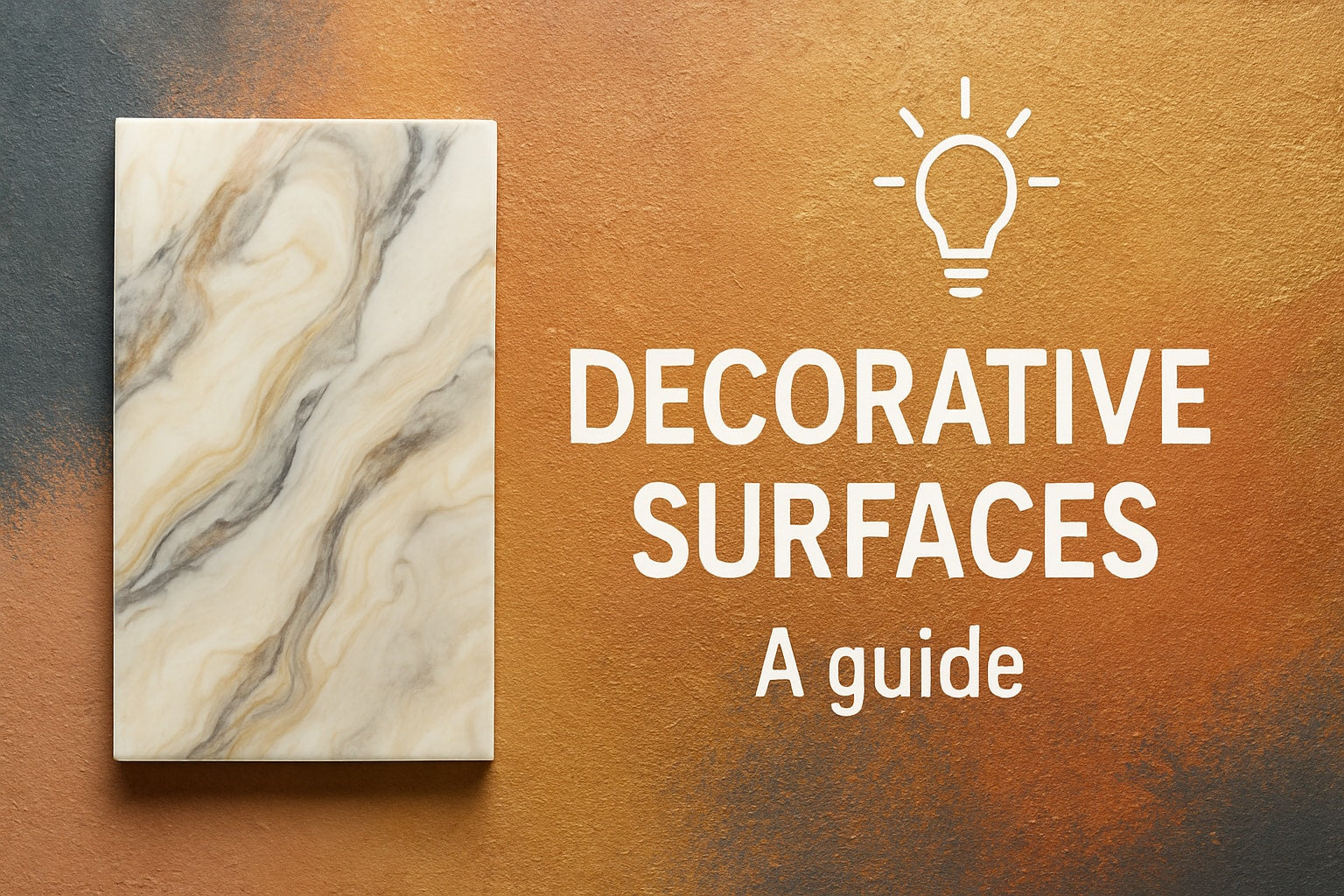
Share:
Country Style Lounge Room Guide: Design Essentials for 2025
Essential Country Interior Style Guide for 2025